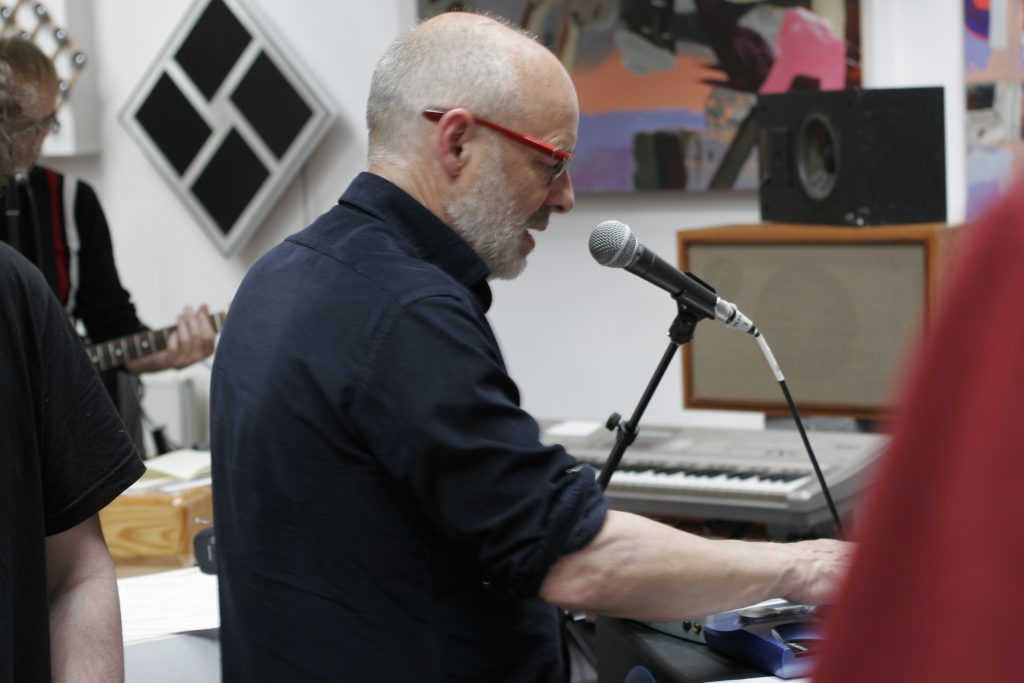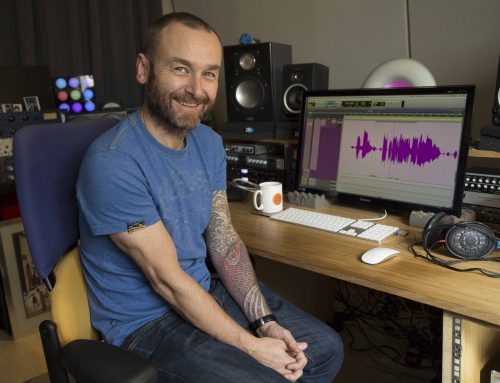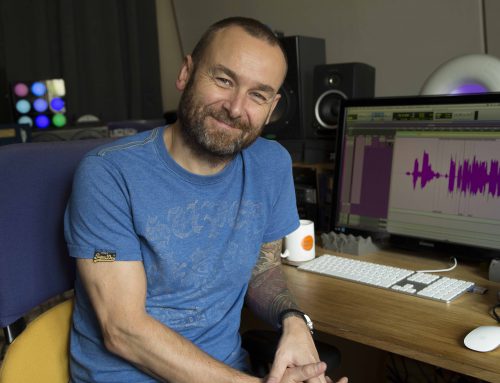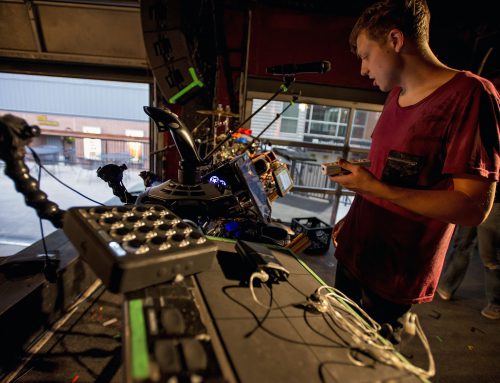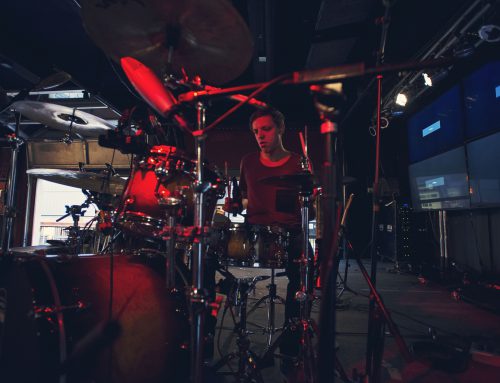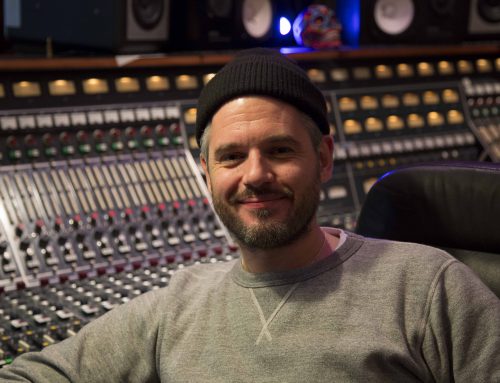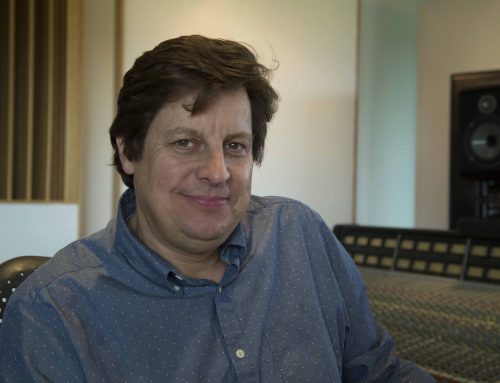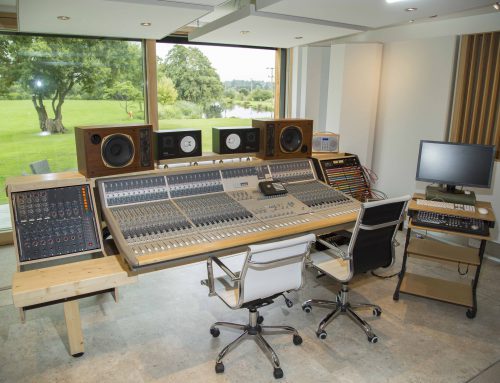Composer and musician Brian Eno reveals the concepts behind his latest album, Everything That Happens Will Happen Today, written in collaboration with David Byrne, and explains the thinking behind Bloom, the generative music software he and programmer Peter Chilvers created for Apple’s iPod Touch and iPhone.
“I had this kind of illumination recently, realizing that you have these different areas of human activity which appear to overlap, which are basically sex, drugs, art and religion,” laughs Brian Eno, demonstrating his thoughts by drawing four oval shapes in a line across a sheet of paper, each oval overlapping the previous shape slightly. He has just got off the phone having been interviewed by a magazine journalist, apparently obsessed with the technicalities of his work, and, as a result, is keen to talk about concepts and ideas rather than recording specifics. That was so boring,” he shouts to everyone assembled in his beautiful, minimally-arranged West London studio and, half joking, says to us, “go on then, bore me!” For someone held in such high esteem as a visionary record producer, sound experimentalist and leading ambient composer, Brian does remarkably few music technology interviews, although his frustration with the painstaking approach of his previous interviewer is perhaps an indication as to why this is the case!
The reasons for our interview are twofold. The first is to discuss the release of Bloom, a simple-to-use music program specifically designed for downloading into an Apple iPod Touch or iPhone and created by Brian together with software developer and fellow ambient music composer Peter Chilvers. “One of the things I am very concerned about is that people realize that this is a joint project,” insists Brian, calling Peter over to take part in the interview, “because I see it mentioned as Brian Eno’s Bloom, but it’s actually Pete’s work as well.”
The second reason we have an appointment with Brian, less than an hour before he is due to start the first of several studio sessions working with U2, is to find out more about his gospel-influenced album Everything That Happens Will Happen Today, written and recorded alongside Talking Heads front-man David Byrne, and released in the summer of 2008 as a download, and more recently in hardware form.
The Gospel According to Eno
Above the four overlapping ellipses, Brian sketches a sort of umbrella line and writes ‘Surrender’ by it, as part of his explanation as to why two confirmed atheists decided to make an album inspired by the Christian gospel music.
“I had become more and more interested in trying to make a constellation of music that I’d previously only listened to.” He explains. “I had been listening to gospel music for years, which is interesting because I’m an atheist, but there is something I love about the inclusiveness of gospel – the way it’s designed to include people rather than exclude them. It uses very simple chords, generally. It’s community music. I love joining in with it and I found that I more and more wanted to hear songs like that.
“But I also wanted to hear them free of the religious content that gospel songs have; not because I’m as dismissive of that as Richard Dawkins might be, but because I found it too narrow. It wasn’t me: it isn’t the terms that I think in.
“I think that sex, drugs, art and religion very much overlap with one another and sometimes one becomes another. So I thought, ‘What do all those things have in common?’ The umbrella that they all exist under is this word, ‘surrender’ because they are all forms of transcendence through surrender. They are ways of transcending your individuality and sense of yourself as a totally separate creature in the world. All of those things involve some kind of loosening of this boundary that is around this thing you call ‘yourself’.
“In Gospel music you do it by surrounding yourself in the inner community, so you are no longer you and become a part of ‘us’, and, of course, that’s what happens in sex, if you enjoy it!
“This idea of surrender has become more and more what I’ve been thinking about for the last few years, and I’ve been wanting to make both visual art, which I do a lot of, and music, which says to an audient, ‘This is where you can surrender!’ I consider surrender an active verb, in the sense that you have this spectrum ranging from control to surrender, and the model of post-enlightenment man is that we’ve become better and better at control. If you think of our distant genetic past, most of our time was spent around the surrender end of the spectrum because there wasn’t much we could control. We were at the mercy of weather, creatures, geology, geography and everything else. We had to learn to surrender in a situation because when you are powerless, your option is to go with the flow and learn how to navigate it. That’s what I call active surrender.”
Everything That Happened
Long before Brian and David decided to make an album, the raw ideas that eventually kick started the project were being developed by Brian in his studio, predominantly using Logic Audio and software processors rather than hardware. Although one corner of the studio is still occupied by a work bench and tools, Brian explains that a dislike of soldering leads is one of the reasons why he has mostly abandoned hardware, another reason being that rewiring a patch is simpler in the virtual world.
“I’m always working on music,” he explains, “starting things and following them in a sort of experimental way without any idea of where they will end up. Sometimes they just start because I’m interested in a new piece of software or a new tool and I’m thinking, ‘What can you do with that?’ And if it turns into something I enjoy listening to I store it. “I’ve got something like 5000 pieces stored in my computer – pieces that I started but haven’t necessarily concluded as anything other than sonic experiments. But sometimes those things take on more and more form and start to acquire an emotional world. Sometimes I release them, and that’s actually what my albums come from: they come from experiments gradually becoming more than experiments!
“For the album, there was a certain group of pieces that seemed to me obviously destined to become songs because they had the structure and shape, as opposed to sonic landscapes – which would be the more ambient stuff that I do – or just rhythm experiments, which I do a lot of as well. A lot of my rhythmic work I take to people like U2, for example, and together we turn it into something. But these were pieces that I felt really needed proper songs and the craft of a songwriter.
Having previously worked with David Byrne on Talking Heads albums such as Remain In Light, and as a duo, creating the album My Life In The Bush of Ghosts, the pair were in regular contact, and began discussing a seemingly shared musical vision. “David is also very moved by gospel music and an atheist. This seems paradoxical because people tend to judge music by the content of its lyrics, which I never have done; I’ve never really been particularly interested in the specific content of lyrics, more in the emotional world that they trigger in you.
“Quite early on we had this idea of what sort of world of music we were entering into. In fact, the first song we worked on was ‘One Fine Day’, and that’s very clearly an inspirational ‘sing with us,’ type song. It’s not like a Talking Heads or Brian Eno song; it’s something that neither of us has done before. ‘Home’ is another example of us trying to make something that you feel that you have to sing along with it. So it wasn’t about being technically clever at songwriting, it’s about making something that anybody could sing.”
Collaboration By Proxy
One of the more unusual aspects of the Eno/Byrne collaboration is that most of it was done by posting ideas back and forth, rather than spending time in the studio together. Initially, Brian sent David his selected batch of ideas simply recorded in stereo on a CD. This, incidentally, is the method he’s also recently used to share working ideas with both David Bowie and Robert Wyatt.
Remarkably, many of these raw ideas, developed by Brian on his own using Logic Audio, remained almost untouched through to the final mix, forming the entire base of a song. “David wrote all the songs over demo mixes, basically. In some cases,” like ‘Home’ and ‘One Fine Day’ the whole backing track is what I sent: the music remained exactly as I sent it. He put my stereo files into Logic and then did his vocals over the top. He sometimes edited the structure, by cutting and pasting, if he felt that it needed a bit more somewhere. He did that on a couple of occasions and added things in a few places, such as guitar and piano. Mostly the piano was mine though, and generally you can say that most of the music is mine and most of the lyrics are his.
“Occasionally, he would come up with a song and after I’d listened to it, I’d think, ‘He could do with another chorus,’ so I’d just edit it and chop together another version. So, I sometimes changed the structure when I heard what he had done.”
As the album’s credit notes indicate, a number of tracks include contributions from various other musicians, some of them recorded in the US by David, others in the UK by Brian. “When I was making the original music there were always musicians dropping in here, so I’d often ask if they could stick on a bit of guitar or whatever. Because of that there were already some casual additional players on the things I sent to David. Then, quite late in the project, he decided that it would be nice to have this percussion player he’d been working with on some things, and there were a couple of things he wanted brass on having worked with these brass players. In the mean time, as the project started to become more real, I thought we’d need a bit of guitar action, so I asked my friend, Leo Abrahams to play on some tracks.”
Asked if he processed the performances of his live musicians, Brian simply replies, “You bet I did, I never stop processing!”
Eventually, the pair arrived at a point where they were ready to mix, however, the original base recordings still did not exist in multitrack form. “In the end, I had to go back to those old Logic files from which these pieces had been made, which was very difficult because sometimes they were archived in very ancient computers. In fact, Peter Chilvers went through and found all the original pieces, which is why he’s credited as digital archeologist. A lot of it was MIDI so he had to print it all, and it was only at that point that we built the multitracks. Then we had to add all of David’s voices and go through everything, sticking them together properly and comping it all. It was a funny reversal of what normally happens.”
To mix the album, the pair called on the services of Patrick Dillett, working at Kampo Studios in New York. Dillett had recently worked with David on a number of projects, so he seemed a good choice. Brian: “I think he’s a great mixer and very conscientious about trying to make sure that he listens carefully to what it was you liked about a piece. He doesn’t really stamp a lot of personality onto the mixes in the sense that you don’t here him very much, but he hears you a lot!”
“If the demo is what you got excited about and is the core of the thing then you should pay attention to it. I do quite a lot of producing and I’m always going back to find the earliest versions of things and saying ‘Let’s not forget what it was that excited us about it in the fist place.’ It’s very easily done if a project goes on for a long time and everybody becomes fatigued. That gap, that once seemed so fantastically charged with absence, gradually gets filled up! People are far more aware of that possibility after they’ve done a few records and had that experience.”
Full Bloom
When it comes to new technology, one of the things guaranteed to really excite Brian is the process of finding out if it is capable of doing something unexpected, and it is this curiosity which eventually led to the creation of Bloom, the generative music application for iPhone and iPod Touch. “I’m sort of on a mission,” he states. “When new media appears, like the iPod, it is for historical reasons. For example, people wanted to carry all their records around and that’s how this technology started. We used to carry a walkman and cassettes so this was invented as a more elegant solution, but, of course, what is always interesting about new technologies is that as soon as they exist, you find that they can do something that nobody ever thought of before. The historical reason for things existing is never the most interesting thing they can do. The recording studio, for example, was invented as a way of giving people better options for balancing the different ingredients of a piece of music after recording, but it suddenly gave rise to a completely new way of making music, which is to record layer by layer and be able to go back to earlier layers and mutate them. The Internet is another very good example of this because it was invented for a very specific military function.
“I spend a lot of my time just looking at what software and new media are capable of doing that nobody thought it could. It always turns out that they have some other potential to let us do something that we couldn’t do before, and perhaps we didn’t even think we wanted to. We never really realize what our inventions are good for unless we start playing with them and trying different things with them.”
The origins of Bloom can be traced back to when Brian created the music for Electronic Arts’ Spore video game, which was something Peter Chilvers was involved with as a programmer and composer. “When I was asked to work on Spore,” Brian recalls, “I think they wanted me to make them a few prerecorded loops, but the interesting thing to me was that Spore was a generative game in the sense that it built itself as it went along, and I thought that maybe I should try to reflect that in the music. I wanted to have music that didn’t repeat itself identically and my interest in it was because I’d been going on about generative music for years and it seemed like it might be a place where it could find an outlet. I’d already talked to Peter about various things, so I thought I’d get him to help me with this problem, and it turned out to be a very good collaboration because he’d worked with generative music and knew it very well. But it became more than a relationship of artist and technician, and much more about two people with quite a lot of overlap in what they were doing. It was so nice to listen to it and say, ‘I think it would be better if we did this,’ and have Peter say ‘I can do that, but I can also do this!’ That was very much a part of it: Peter not only understanding the artistic project, but also knowing how the software works and being able to suggest other options.
“The soundsthat came out of the Spore project where we worked together proved that we could make artistically successful generative music you’d actually want to listen to. It’s quite easy to make generative music that’s functional but you don’t want to listen to it!”
Looking Inside
Bloom’s programmer, Peter Chilvers, explains that the program is actually fairly simple and has very few variables, but the way that it is programmed makes it audibly complex and random enough for it to appear rather more controllable than it is in reality. The notes are all derived from just a couple of source sounds created by Brian. According to Peter, one of these was created by some extreme processing of a guitar chord, hugely slowed down and affected, the other, generated using Logic’s ES1 synthesizer, treated with reverb and other effects. The rest of the notes played by Bloom are simply variations of the above, slowed to create the notes in the scales.
“If you leave it alone for a while it will start playing around with whatever you have done,” explains Peter, “possibly playing the notes in a different key, maybe slightly faster or slower, and possibly backwards. It’s all data, almost like MIDI, so it’s very simple. The memory just stores the position of each screen tap and the time you tapped it.”
“I think the screen is split into about 24 intervals from top to bottom. Left to right actually does nothing at the moment, and the screen is not touch sensitive. The really odd thing is that some people have been trying to work out what left to right does and have attached all kinds of meaning to it. Someone wrote me a detailed thing saying that on the left the delay is shorter and someone else had attributed a very elaborate set of tonal controls.”
“It is possible to do stuff with sliding fingers but I think there is something very satisfying with how it just ripples. For this sound it feels like it should be just a quick impact and that’s all. I didn’t feel sustaining would quite work with it.
“I’d love Apple to add touch sensitivity because there is a lot that can be done with it but I’ve no idea what they have planned and they’re notoriously cagey about the future. There are all kinds of thing rumored which are of great interest to me.”
All In The Delay
Anyone who has had the chance to experiment with Bloom will have gained a sense of how it subtly alters a played sequence over the course of time. This strange effect is a result of the way Peter’s delay algorithm has been programmed. “It’s a very unusual algorithm,” continues Peter. “It sounds like it’s an ordinary delay but its not: the delay is constantly varying, so if I play a note now I might get a delay of four seconds but if I play a note ten seconds later I might get a delay of five seconds. However, the delay associated with each note remains the same, so if I play a note now and the delay is 4.9 seconds it will repeat with a delay of 4.9 seconds. The delay time changes very slowly so if you play a set of notes close together they will probably stay together, but you can get some very peculiar effects as everything drifts out over time. It’s a bit like bell ringing.
“It’s getting an update about 60 times a second but it’s not very accurate and there are probably better and more reliable ways to do it, but we found from the early demos that the mistakes were quite interesting and made it sound a little more human. We have had people ask for a metronome but it’s the looseness that is nice about it.
“One of Brian’s ideas was to allow the delay to go up to enormous lengths. Initially I had it going to 10 seconds but he wanted two minutes. It does let you be very sparse and do some very long textures. You can also set it to two minutes, plays some notes, then change it to one minute and the two minute delay will carry on going, even though the new notes have the one minute delay.
“The only other parameter is Mood which is another of Brian’s contributions. There are nine settings, which are actually different modes. None of them are very standard keys so they all sound slightly odd and unnerving. Brian has a very good grasp of modes and how to make something sound slightly unsettling by taking it out of ordinary keys. I hadn’t noticed, until I started working with Brian, that this it is quite a trait of his. If you change mode while it’s playing, it keeps all the positions that you’ve played on the screen, but some of the notes might be flattened or sharpened.”
Peter reveals that future versions of Bloom are under consideration, but nothing is definite at the moment. There is, however, another generative project being worked on, although is something separate from Bloom. “Bloom has such a nice simple character – anyone can play it – and our prime concern is that any feature we add should not make it more complicated,” Peter insists. “It’s got to be all in the background in some way. If Apple improved the interface in some way, then I’m sure we would work on ways to exploit it. The lovely thing with iPhone development is that it’s so fluid. The second you release and update it’s there for people to download. It’s also a nice safety net as a developer, because if you make a mistake you can correct it. iPhone development has enabled individuals and tiny groups to do something. Bloom was only commercially viable because it is so easy for us to produce, distribute and for people to buy – it’s the perfect combination. So even though it’s selling cheaply, it’s selling very nicely and made it to number 2 in the Japanese iPhone charts, which we are rather chuffed with. When you think of what it’s competing with, it’s great that a creative application can do that.”
Surprisingly, Peter doesn’t know how much memory there is to play with, but there certainly seems like there is scope for expanding the program’s capabilities. “It sounds strange but I’ve not hit the limit but I’ve not really tested it. At first I was very unsure about how far it would be able to go so I was more conservative than I needed to be. We could probably extend it.”
The Art And The Science
From Brian’s point of view, Bloom is exciting because it breaks down so many barriers. “It sits on a kind of cusp between science, a demonstration of some kind, a piece of music, composition and artifact,” he explains. “If you think about the history of recorded music, prior to recorded music, all music was ephemeral – it happened, then it was gone, and it was therefore totally connected to a time and a place. When recording came along, suddenly you could trap a piece of time and relocate it, so you freed music from time and space, but, of course, that made it entirely repetitive. I think that in 100 years time we might start to realize that the CD player is the 20th century version of the music box in that it just does the same thing over and over, so what was interesting to me about generative music was making something that has a musical identity but doesn’t repeat identically. So what we’ve got here is not so much a tool for making music, but a piece music written by us two, which happens to appear differently each time you play it. It has an identity because it’s always going to sound pretty much like this – the constraint of the piece is that it’s always got these colours.”
On the face of it, Bloom and Everything That Happens Will Happen Today, appear to be two totally different projects, but when looked at side by side, the fascinating thing is that Brian has used the same experimental approach for the realization of both. “The music’s comes from following that process of experimenting and then getting a combination of two excitements. It doesn’t satisfy me to just make something I’ve never heard before; it’s also about creating an interesting feeling that I haven’t experienced before. This gives me a new feeling, I like it!” TF

